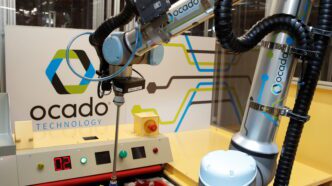Ocado is tackling long-standing fulfilment challenges in online grocery and logistics by introducing AI-driven robotic arms. These advanced machines are equipped with smart sensors and machine vision to accurately pick and pack a wide range of items, including irregular or delicate products.
Through machine learning, the robots adapt in real time, learning from human demonstrations to improve their handling techniques. This innovation significantly boosts warehouse efficiency and throughput, all without expanding physical space.
By automating the picking and packing process, Ocado’s robotic arms reduce dependency on human labor and cut operational costs, signalling a major shift in the logistics industry.
Efficiency at Scale: The OGRP System
Ocado’s robotic technology, known as On Grid Robotic Pick (OGRP), has already proven effective at scale. In 2024 alone, over 30 million items were picked using a small number of robotic arms. The company plans to expand the use of this technology significantly in the coming year.
To further enhance its robotic system, Ocado is exploring diffusion models, a cutting-edge machine learning technique that underpins many generative AI breakthroughs. This could unlock new levels of efficiency and further generalize robotic skills across multiple fulfilment scenarios.
The Unique AI Challenges of Grocery Logistics
Grocery fulfilment presents unique challenges for AI due to the vast number of stock keeping units (SKUs) and the need to handle diverse items with care. Conditions vary from frozen to ambient and chilled, and items must be packed efficiently to prevent damage.
Ocado’s AI solution addresses these challenges through a combination of autonomous decision-making, computer vision, and real-time learning. This enables the robots to manage complexity, adapt to different products, and maintain precision in fast-paced environments.
Benefits of Ocado AI Robotic Arms
- Accurate item picking
- 24/7 operational capabilities
- Fragile item handling
- Improved labor productivity
- Optimized packing efficiency
- Lower dependence on manual labor
The robotic arms are trained using reinforcement learning and behavior cloning, allowing them to continuously improve. Learnings from one robot can be shared across the entire fleet, creating a network of intelligent machines that evolve together.
Behind Ocado AI: Vision, Sensors, and Learning
Ocado’s robots rely on a powerful mix of AI technologies:
- Machine Learning for real-time adaptation and decision-making
- Computer Vision to distinguish between products and packaging
- Smart Sensors to apply the right grip pressure and movement
These capabilities help the system understand how to handle products it has never seen before and refine its performance through ongoing feedback and training.
Ocado’s innovation showcases how AI and robotics can solve complex, real-world problems. Their approach—especially in applying fleet learning—demonstrates how advanced AI models can operate in dynamic environments, adapt quickly, and scale globally.
By setting a new standard for logistics automation, Ocado is redefining what’s possible in the grocery supply chain and influencing broader applications of AI in operationally intensive sectors.













